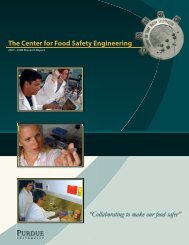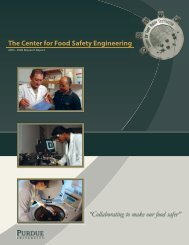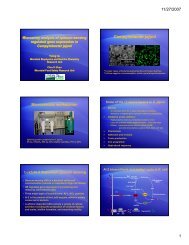J. Irudayaraj - Center for Food Safety Engineering - Purdue University
J. Irudayaraj - Center for Food Safety Engineering - Purdue University
J. Irudayaraj - Center for Food Safety Engineering - Purdue University
You also want an ePaper? Increase the reach of your titles
YUMPU automatically turns print PDFs into web optimized ePapers that Google loves.
Nanoparticle-based DNA multiplexed<br />
probes <strong>for</strong> pathogen detection using<br />
confocal raman microscopy<br />
PI: Joseph <strong>Irudayaraj</strong>, <strong>Purdue</strong> <strong>University</strong><br />
Collaborator: Chobi Debroy, Penn State <strong>University</strong><br />
Graduate Researcher: Lan Sun<br />
Agricultural and Biological <strong>Engineering</strong><br />
<strong>Food</strong> Science<br />
Bindley Bioscience <strong>Center</strong><br />
Funding: New Investigator Grant, <strong>Center</strong> <strong>for</strong> <strong>Food</strong> <strong>Safety</strong> <strong>Engineering</strong>
Specific Aims<br />
‣ investigate the effectiveness of several fluorescent or nonfluorescent<br />
dyes as raman labels to be used as SERRS tags<br />
‣ synthesize SERRS-DNA probes to detect species-specific<br />
DNA sequences of E. coli O157:H7, Campylobacter sp.,<br />
Staphylococcus aureus, Listeria monocytogenes, and<br />
Salmonella sp. as targets<br />
‣ develop a one-pot multiplex protocol using optimized<br />
SERRS DNA probe to simultaneously detect E. coli<br />
O157:H7, Campylobacter sp., and Salmonella sp. in milk<br />
and/or water samples
Probe fabrication<br />
Raman tag<br />
Au particle<br />
dsDNA<br />
Biotin<br />
Streptavidin<br />
Magnetic<br />
particle
S<br />
Multiplex Detection Schematic
Procedures to fabricate<br />
SERS-DNA probes<br />
Step 1:<br />
Direct attachment of thiol modified oligos to<br />
gold nanoparticles<br />
Step 2<br />
Direct attachment of non-fluorescent Raman<br />
tags to gold nanoparticles
Confirmation of the Attachment of<br />
DNA Primer to Gold Nanoparticles<br />
UV-Vis spectroscopy<br />
A shift of 4nm was observed when thiolated<br />
DNA primer was bound to gold particles.<br />
Absorption at 260 nm<br />
Surface coverage: ~8.3 pmol/cm 2<br />
Raman spectroscopy<br />
Characteristic peaks from DNA was<br />
observed when DNA primer was bound to<br />
gold particles<br />
Theoretical Calculation<br />
Surface coverage: ~19.2 pmol/cm 2
Visible shift in absorbance when DNA primer is bound to gold particles<br />
[With non isotropic structures more pronounced shift can be observed]
Band assignment of the Raman signatures<br />
Bands (cm -1 )<br />
Tentative<br />
assignments<br />
Molecular origin<br />
~726 Adenine Nucleic acids 6<br />
~781 Cytosine Nucleic acids 6<br />
~1090 O-P-O - Nucleic acids 6<br />
~1335 Adenine, Guanine Nucleic acids 6<br />
~1372 Adenine,Guanine,<br />
Thymine<br />
DNA 26<br />
References<br />
Primer sequence: 5’ AAA AAA AAA AGC TAG TTC TGT GGT GGA TTG TTG TC 3’<br />
Observed peaks in experiments<br />
Adenine Guanine Cytosine Thymine O-P-O -<br />
DNA primer 728,<br />
1331,1373<br />
1331, 1373 784 1373 1096<br />
DNA primer<br />
bound to gold<br />
particles<br />
728 1338 781 1092
Raman spectra of (A) glass slide (B) gold particles on glass slide (C) DNA primer (3µM) on gold slide<br />
(D) DNA primer (3µM) bound to gold particles. Acquisition parameters: 785nm excitation, 50× objective, 20s<br />
integration, 3 co-additions, 100mW of laser power <strong>for</strong> (C) and 10mW of laser power <strong>for</strong> (A)(B)(D).
0.9<br />
0.8<br />
0.7<br />
0.6<br />
dye-1:DNA dye-2:DNA dye-3:DNA dye-4:DNA<br />
dye-5:DNA dye-6:DNA dye-7:DNA dye-8:DNA<br />
Dye-1:<br />
4-Mercaptopyridine<br />
Dye-2:<br />
2-Thiazoline-2-thiol<br />
Dye-3:<br />
4,6-Dimethyl-2-pyrimidinethiol<br />
Intensity (a.u.)<br />
0.5<br />
0.4<br />
0.3<br />
0.2<br />
0.1<br />
Dye-4:<br />
2-Thiouracil<br />
Dye-5:<br />
1,2-Di(4-pyridyl)ethylene<br />
Dye-6:<br />
3-Amino-1,2,4-triazole-5-thiol<br />
Dye-7:<br />
1H-1,2,4-Triazole-3-thiol<br />
0<br />
0 500 1000 1500 2000<br />
Wavenumber (cm -1 )<br />
Dye-8:<br />
Pyrazinecarboxamide<br />
Raman spectra of individual SERS-DNA probes
Characterization of the eight SERS-DNA probes<br />
Dye-1:DNA 1606, 1465, 1264, 1204, 1194, 1173, 1089, 1026, 998, 813, 712, 696, 660, 646,<br />
494, 416<br />
Dye-2:DNA 1487, 1345, 1293, 1255, 1192, 1145, 1069, 1021, 999, 959, 935, 862, 759, 730,<br />
691, 650, 593, 575, 524, 489, 450, 413<br />
Dye-3:DNA 1579, 1518, 1471, 1419, 1378, 1334, 1234, 1186, 1098, 1000, 977, 870, 747, 726,<br />
667, 569, 484, 441<br />
Dye-4:DNA 1689, 1559, 1470, 1439, 1381, 1315, 1251, 1216, 1158, 1063, 997, 960, 920, 853,<br />
815, 710, 638, 565, 505, 438<br />
Dye-5:DNA 1636, 1607, 1543, 1489, 1335, 1314, 1242, 1198, 1061, 1016, 968, 880, 843, 794,<br />
733, 683, 660, 540, 506<br />
Dye-6:DNA 1537,1480, 1425, 1319, 1271, 1151, 1098, 1016, 816, 781, 728, 651, 562, 483<br />
Dye-7:DNA 1477, 1320, 1173, 1072, 1017, 998, 981, 958, 848, 815, 728, 687, 651, 540, 495<br />
Dye-8:DNA 1558, 1468, 1317, 1259, 1128, 1108, 1047, 1022, 1016, 999, 952, 910, 853, 828,<br />
813, 784, 731, 675, 645, 555, 540, 498, 456
An 8-level multiplexing scheme<br />
1<br />
0.9<br />
mixture-3 dye-1:DNA dye-2:DNA<br />
dye-3:DNA dye-4:DNA dye-5:DNA<br />
dye-6:DNA dye-7:DNA dye-8:DNA<br />
0.8<br />
0.7<br />
Intensity (a.u.)<br />
0.6<br />
0.5<br />
0.4<br />
0.3<br />
0.2<br />
0.1<br />
0<br />
0 500 1000 1500 2000<br />
Wavenumber (cm -1 )
Characteristic peaks observed in mixture-3<br />
Bands from<br />
mixture-2<br />
Assignment<br />
Bands from<br />
dye-1:DNA<br />
Bands from<br />
dye-2:DNA<br />
Bands from<br />
dye-3:DNA<br />
Bands from<br />
dye-4:DNA<br />
Bands from<br />
dye-5:DNA<br />
Bands from<br />
dye-6:DNA<br />
Bands from<br />
dye-7:DNA<br />
Bands from<br />
dye-8:DNA<br />
451 dye-2:DNA 450<br />
489 dye-2:DNA 489<br />
571 dye-3:DNA 569<br />
677 dye-8:DNA 675<br />
683 dye-3:DNA 683<br />
761 dye-2:DNA 759<br />
795 dye-5:DNA 794<br />
826 dye-8:DNA 828<br />
868 dye-3:DNA 870<br />
923 dye-4:DNA 920<br />
981 dye-7:DNA 981<br />
1091 dye-1:DNA 1089<br />
1158 dye-4:DNA 1158<br />
1206 dye-1:DNA 1204<br />
1269 dye-6:DNA 1271<br />
1295 dye-2:DNA 1293<br />
1376 dye-3:DNA 1378<br />
1533 dye-6:DNA 1537
Analysis Steps<br />
Select Primers
Table 1. Primer sequences <strong>for</strong> the detection of bacterial targets<br />
____________________________________________________________________________<br />
Species Target Gene Primer sequence (5’-3’) Amplicon size<br />
------------------------------------------------------------------------------------------------------------------<br />
E. coli O157:H7 * hlyA gene GTAGGGAAGCGAACAGAG 361 bp<br />
AAGCTCCGTGTGCCTGAA<br />
Campylobacter 16S rRNA GGATGACACTTTTCGGAGC 816 bp<br />
genus **<br />
CATTGTAGCACGTGTGTC<br />
Salmonella sp. * InvA gene TATCGCCACGTTCGGGCAA 275 bp<br />
TCGCACCGTCAAAGGAACC<br />
Staphylococcus nuclease gene GCGATTGATGGTGATACGGTT 276 bp<br />
aureus *<br />
CAAGAATTGACGAACTAAAGC<br />
Listeria mono- hemolysin CGGAGGTTCCGCAAAAGATG 234 bp<br />
cytogenes *<br />
CCTCCAGAGTGATCGATGTT<br />
--------------------------------------------------------------------------------------------------------------------
TEM images of anisotropic gold nanostructures<br />
Cubes and low aspect ratio rods Star Hexagon<br />
Group of irregular particles<br />
Bird Wing<br />
Dog bone
Deliverables<br />
Optimization of SERRS effect of dye/gold particle<br />
size and excitation wavelength and concentrations<br />
with multiplexing (4 months)<br />
Fabrication of SERRS tagged DNA probes <strong>for</strong><br />
each of the five target pathogens and multiplex<br />
demonstration (3 months) - In progress<br />
Design and implementation of a one-pot analysis<br />
assay <strong>for</strong> pathogen detection using SERRS DNA<br />
probes (5 months)
IGAuN Concept
Nucleus<br />
Blank Passive uptake IGAuN<br />
Laser scanning confocal reflectance imaging with silver enhanced visualization of IGAuNs
Dark-field imaging to visualize nanoparticles in live cells<br />
and SER Raman <strong>for</strong> molecular fingerprinting<br />
Acknowledgement: Rajwa, B., Robinson P<br />
IGAuN<br />
IGAuN induced SERS spectra are indicative of<br />
sensing cytoplasmic or nuclear matrix
An IR-Biosensor via Chalcogenide (Ge 28 Sb 12 Se 60 ) film<br />
Ultimate Goal:<br />
To develop a microarray<br />
type biosensor using the<br />
Chalcogenide (Ge 28 Sb 12 Se 60 )<br />
film as supporting substrate<br />
and build-in waveguides as<br />
signal collecting channels.<br />
300~500 nm<br />
Evanescent wave<br />
absorption<br />
Incoming<br />
IR beam<br />
HOOC-xxx-S-<br />
Chalcogenide film (GeSbSe)<br />
Key points:<br />
1. Chalcogenide film has good IR<br />
transparency allowing strong evanescent<br />
wave to produce good IR signals.<br />
2. Multilayer (anchor layer, capturing layer<br />
and target layer) structure can be<br />
constructed on the film.<br />
3. Target binding event can be monitored<br />
by characteristic IR spectral signatures<br />
To<br />
detector<br />
IR spectra measurement<br />
>300 nm<br />
GeSe 2<br />
cladding layer<br />
~30 nm<br />
Gold<br />
coating<br />
Silicon substrate<br />
antibody<br />
Target (bacterial cells)<br />
<strong>Irudayaraj</strong>, Jain, Pantano groups
Detection of binding of the bacterial targets to the sensor film:<br />
Specificity study<br />
Notes:<br />
Sensor film surface is functionalized with anti E. coli. O157:H7 antibodies, the<br />
specificity of the sensor is investigated by exposing the sensor to different<br />
bacterial samples and compare the responses.<br />
Absorbance, arbitrary unit<br />
treated with E. coli K12<br />
treated with S. enteriditis<br />
treated with E. coli O157:H7<br />
untreated functionalized blank film<br />
Si band<br />
700 800 900 1000 1100 1200 1300 1400<br />
Wave numbers, cm -1<br />
E. coli K12 and S. enteriditis cells are<br />
not specifically bound to the sensor<br />
film, which is functionalized with anti E.<br />
coli O157:H7 antibodies. Hence treating<br />
with these two bacterial suspensions<br />
should have no effect and their<br />
spectral signatures should be<br />
comparable to untreated “blank” film.<br />
On the other hand, treating with E. coli<br />
O157:H7 will trigger specific binding,<br />
hence completely different response of<br />
the sensor.
Further confirmation: S. enteriditis as targets<br />
Sensor film surface is functionalized with anti S. enteriditis antibodies, the<br />
specificity of the sensor is investigated by exposing the sensor to different<br />
bacterial samples and to bacterial cocktails (mixture of three different bacterial<br />
suspensions).<br />
absorbance, arbitrary unit<br />
treated with E. coli K12<br />
treated with S. enteriditis<br />
treated with E. coli O157:H7<br />
treated with PBS buffer<br />
treated with E. coli cocktail<br />
treated with all-three cocktail<br />
Good specificity is achieved in<br />
case of bacterial cocktails as well,<br />
the presence/absence of the target<br />
strain (S. enteriditis) in a bacterial<br />
cocktail is correctly reported by<br />
the sensor.<br />
700 800 900 1000 1100 1200 1300 1400<br />
Wave numbers, cm -1
10 8 CFU/ml, 5 mins<br />
10 3 CFU/ml, 45 mins<br />
10 6 CFU/ml, 5 mins<br />
Results obtained after prolonged<br />
treatment with low concentration<br />
sample yield almost identical<br />
signatures as results obtained from<br />
high concentration samples,<br />
suggesting that sample<br />
concentration is not the main factor<br />
dictate the lower limit of the<br />
sensitivity.<br />
800 900 1000 1100 1200 1300 1400<br />
Nevertheless, the sensor is<br />
sensitive enough to detect<br />
target bacterial cells at a low<br />
concentration (10 3 CFU/ml)
Biomimetic color nanocomposites<br />
50 %<br />
Diynoic acid<br />
+<br />
50 %<br />
Natural Lipids<br />
1. Sonication<br />
2. UV irradiation<br />
50 – 300 nm<br />
Ben Gurion Univ (Collaborator: Jelenik group)
agar<br />
Bacterial colony<br />
Lipid/PDA film<br />
Color coding<br />
S. typhimurium E. coli
Elucidating antibiotic resistance of bacteria<br />
Kanamycin present in agar/polymer matrix<br />
Salmonella WT<br />
Salmonella<br />
(kanamycin-resistant)<br />
E.Coli MC4100
Application: Colorimetric screening of bacterial contamination<br />
Control<br />
Fresh milk<br />
“fresh” liver
Thank You












